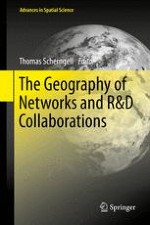2013 | OriginalPaper | Chapter
4. Determinants of Cross-Regional R&D Collaboration Networks: An Application of Exponential Random Graph Models
Authors : Tom Broekel, Matté Hartog
Published in: The Geography of Networks and R&D Collaborations
Publisher: Springer International Publishing
Activate our intelligent search to find suitable subject content or patents.
Select sections of text to find matching patents with Artificial Intelligence. powered by
Select sections of text to find additional relevant content using AI-assisted search. powered by
